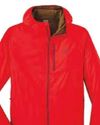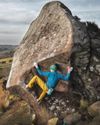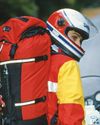UELI STECK was a global phenomenon in alpine climbing. He electrified the world with his ming-blowing speed and solo mountaineering exploits-so much so that people came to think of him as superhuman, a conciet abruptly overtuned by the shocking news of his death at just 40 while training on Nuptse. Leavin us to wonder: Just how did a seemingly normal Swiss guy from a town of hockey fanatics and dairy farmers transform himself into the world's foremost alpinist?

Ueli Steck was born on October 4, 1976, the youngest of the three sons of Lisabeth and Max Steck, a local coppersmith. Their valley, where the Emme river flows, is known as the Emmental, part of the canton of Bern, one of the largest of Switzerland’s 26 cantons, or states. It bears a soft wildness in its steep, verdant hills and rolling farmland. The Swiss farming houses here typically have huge roofs that almost seem to touch the ground. Though the family lived only a short height above ground on the first floor of their home, Ueli as a young boy more than once horrified his mother by climbing to the outside through the kitchen window and onto the gutter, incidents she recalled with a laugh for a local Swiss newspaper last year.
Folks sometimes sound as if they are speaking a little more slowly and melodically in Swiss German, perhaps reinforcing the cliché of a place considered friendly, easygoing and a bit introver ted—al l characteristics of Steck, who also learned French, English and Italian. In his hometown stands the oldest free church of Switzerland, a place where zealous Mennonites once gathered to escape persecution in the first half of the 16th century. But for his family, nature above all else was a haven, and they took lots of walks together, as is customary in Switzerland. His mother and father encouraged the three sons always to give their best and do the right thing. They lived not far from the Bernese Alps and Jura mountains, and the boys were accustomed to taking to the outdoors and playing sports to deal with the varied stresses of growing up, school and work. Among the Swiss, as with most Europeans, the team sports of hockey and soccer are the most popular. Steck joined in like everyone else, but he didn’t see himself as a natural-born athlete.
This story is from the October 2017, #245 edition of Rock and Ice.
Start your 7-day Magzter GOLD free trial to access thousands of curated premium stories, and 9,000+ magazines and newspapers.
Already a subscriber ? Sign In
This story is from the October 2017, #245 edition of Rock and Ice.
Start your 7-day Magzter GOLD free trial to access thousands of curated premium stories, and 9,000+ magazines and newspapers.
Already a subscriber? Sign In
Call of Duty
Vikki Weldon: Hard lines and the front line
THE BADGE
WE DEFINE OURSELVES AS CLIMBERS, BUT IS THAT GOOD ENOUGH?
THE ACHIEVER
MARICELA ROSALES HAD EVERYTHING AGAINST HER. SHE BECAME A CLIMBER ANYWAY.
Chris Sharma
FIRST ASCENTIONIST, FORMER WORLD CHAMPION, OWNS GYMS IN SPAIN AND USA. INTERVIEWED IN QUARANTINE IN BARCELONA WITH HIS WIFE, 3-YEAR-OLD DAUGHTER AND 1-YEAR-OLD SON.
PROJECT WAIT
A LIFELONG CLIMBER CONSIDERS THROWING IN THE TOWEL
Older, Wiser, Stronger!
YES, THEY CAN GO TOGETHER. HOW TO TRAIN STRENGTH AS YOU COME ALONG DOWN THE ROAD.
CALCULATED RISK
HOW UNDERSTANDING DANGER COULD KEEP YOU OUT OF HARM’S WAY

Accessories To Climb
Field tested

To The Grit
About 10 winters ago I touched down in Manchester in a hard, driving English rain. The city was hidden from view. I was groggy after a red-eye from Dallas, an over-brewed black tea barking on my dry tongue.

The Wild Ones
North Conway is a typical New Hampshire town tucked among rolling hardwood hills and set at the foot of imposing granite slabs, but 30 years ago it was the stage on which a small band of climbers led the way in boldness and vision.